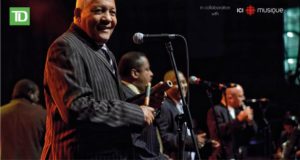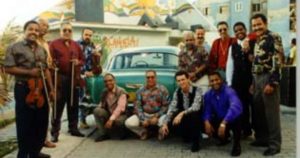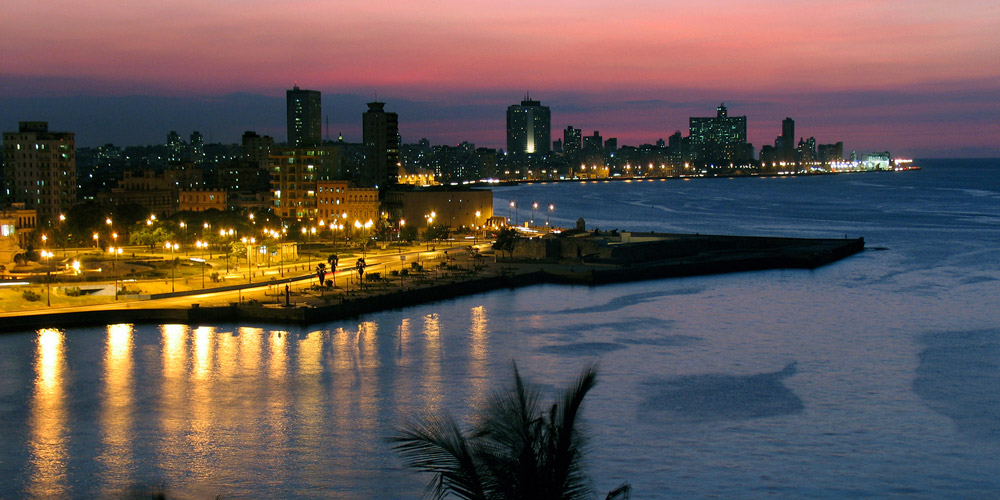This is a prestigious Cuban musical group, an interpreter of popular dance genres. It was founded in 1939 in French charango format, by Orestes Aragón, who was a carpenter by profession, in his native city of Cienfuegos. La Charanga Aragón emphasized its three violins, the flute and the cello describing the string music that was originally played in the dances and parties of the white bourgeoisie halls. Years later the Aragon settled in Havana, to establish itself during decades in the top among the orchestras of its type in Cuba.
La Charanga was born at the beginning of the last century … “emerged as a variant of the typical Cuban orchestra of the nineteenth century, an orchestra of metals then known as Charanga French, his style is defined by the flute and violins, absent in other orchestrations. They completed their endowment: the timbal, the güiro, the piano (incorporated in 1901), the contrabass and later the tumbadora. The Charangas interpreted the dance, the danzonete, the bolero song, and from the fifties, the Cha Cha Tea. “…
In 1948 its creator ceded the baton to also cienfueguero and then young teacher, violinista and singer Rafael Lay Apezteguía (1927-1982). The Orquesta Aragón de Cuba represents and gives name to the charangas that appeared in the Caribbean when the twentieth century began. In times of Cha Cha Tea “La Charanga Eterna” took over that rhythm and made famous the unforgettable flutist Rafael Egúes, who was in the orchestra until 1984 achieving successes like The Bodeguero, Nosotros and Pare cochero.
The Cha Cha Tea mania brought a much larger audience to the Aragón, and then they moved to Havana and, with Egües, they toured the Americas and began a program on Radio Progreso, which is still being broadcast. Soon, and from the hand of communism, Aragon left for Eastern Europe and then took his Cha Cha Tea to Paris.
As their music grew in popularity, the Cienfuegos Orchestra reached the black continent, where they were ultra famous, for the first time in 1972 when they toured countries like Mali, Guinea, Senegal, Zaire and Burkina Faso.
Throughout these years the orchestra has interpreted hits like El Bodeguero, El cerquillo, Cachita, Pare Cochero, Guajira with tumbao, Tres lindas cubanas and always want me. Between flutes and violins, the Aragon has recorded voices like those of Benny Moré, Perez Prado, Chapotín and many more. Rafael Lay, who was its director since 1948, died in 1982 in a traffic accident, but the orchestra continues its function, to make everyone enjoy under the direction of Rafael Lay hijo.
For more than 60 years several generations of Cubans have danced and enjoyed the music of this orchestra, which is now an institution in national culture.
Today the old lady charanga refuses to succumb to the push of salsa, timba, rap, hip hop, rock, pop and reborn, perhaps because of the good retro streak that touches our music and especially the tenacity of its director Rafael Lay Junior Of preserving the sound essence of the grouping. Rafelito, as the young heir is told, faced difficult stages. The departure of several of its members, some keys like the emblematic and phenomenal flutist Richard Egües; The retirement of Pepe Olmos, voice and former figure heartbreaker of the group; The departure of Felo Bacallao, also a charismatic singer and dancer, were difficult times, in addition to the introduction of a new repertoire that was not comparable to those of his golden age. It seemed that the public that followed did not assimilate the changes and the new ones were not interested in that infectious but somewhat archaic rhythm.
Bolero tea, mambo tea, chaonda, danzón tea, derived from the fusions they always made with other genders. Tombs, bongoes, pailas, strings, piano and bass are accommodated for unforgettable solos in his time Egües and now Eduardo Rubio, who has the difficult task of being in the square of the old master.
La Orquesta Aragón de Cienfuegos cumple 70 años.
Esta es una prestigiosa agrupación musical cubana, intérprete de géneros populares bailables. Fue fundada en l939 con formato de charanga francesa, por Orestes Aragón, que era carpintero de profesión, en su natal ciudad de Cienfuegos. La Charanga Aragón destacaba sus tres violines, la flauta y el cello describiendo la música de cuerda que se tocaba originalmente en los bailes y fiestas de los salones de la blanca burguesía. Años más tarde la Aragón se radicó en La Habana, para establecerse durante décadas en la cima entre las orquestas de su tipo en Cuba.
La Charanga nació a principios del siglo pasado…”surgió como variante de la orquesta típica cubana del siglo XIX, una orquesta de metales conocida entonces como Charanga francesa. Su estilo lo definen la flauta y los violines, ausentes en las demás orquestaciones. Completaban su dotación: el timbal, el güiro, el piano (incorporado en 1901), el contrabajo y después la tumbadora. Las Charangas interpretaban el danzó, el danzonete, el bolero canción, y a partir de los años cincuenta, el Cha Cha Chá.”…
En 1948 su creador cedió la batuta al también cienfueguero y entonces joven maestro, violinista y cantante Rafael Lay Apezteguía (1927-1982). La Orquesta Aragón de Cuba representa y da nombre a las charangas que aparecieron en el Caribe cuando despuntaba el siglo XX. En tiempos del Cha Cha Chá “La Charanga Eterna” se adueñó de ese ritmo e hizo famoso al inolvidable flautista Rafael Egúes, quien estuvo en la orquesta hasta 1984 logrando éxitos como El Bodeguero, Nosotros y Pare cochero.
La manía del Cha cha Chá le trajo a la Aragón una audiencia mucho más grande, fue entonces cuando se mudaron a La Habana y de la mano de Egües recorrieron las américas y comenzaron un programa en Radio Progreso, que aún se sigue emitiendo. Pronto, y de la mano del comunismo, la Aragón partió a Europa del Este y luego llevó su Cha Cha Chá a París.
A la par que su música crecía en popularidad, la Orquesta de Cienfuegos llegó hasta el continente negro, donde eran ultra famosos, por primera vez en 1.972 cuando realizaron su tour por países como Malí, Guinea, Senegal, Zaire y Burkina Faso.
A lo largo de estos años la orquesta ha interpretado éxitos como El Bodeguero, El cerquillo, Cachita, Pare Cochero, Guajira con tumbao, Tres lindas cubanas y quiéreme siempre. Entre flautas y violines, la Aragón ha registrado voces como las de Benny Moré, Perez Prado, Chapotín y muchos más. Rafael Lay, quien fue su director desde 1948, falleció en 1.982 en un accidente de tránsito, pero la orquesta continúa su función, la de hacer gozar a todo el mundo bajo la dirección de Rafael Lay hijo.
Durante más de 60 años varias generaciones de cubanos han bailado y disfrutado la música de esta orquesta, que es hoy toda una institución en la cultura nacional.
La hoy ancianita charanga se niega a sucumbir ante el empuje de salsa, timba, rap, hip hop, rock, pop y renace, quizá por la buena racha retro que toca a nuestra música y sobre todo por el tesón de su director Rafael Lay Junior de preservar la esencia sonora de la agrupación. Rafelito, como se le dice al joven heredero, se enfrentó a etapas difíciles. La salida de varios de sus miembros, algunos claves como el emblemático y fenomenal flautista Richard Egües; la jubilación de Pepe Olmos, voz y otrora figura rompecorazones del grupo; la salida de Felo Bacallao, también carismático cantante y bailador, fueron momentos difíciles, además de la introducción de un repertorio nuevo que no se comparaba con los de su etapa de oro. Parecía que el público que la seguía no asimilaba los cambios y a los nuevos no les interesaba ese ritmo contagioso pero algo arcaico.
Bolero chá, mambo chá, chaonda, danzón chá, derivaron de las fusiones que hicieron siempre con otros géneros. Tumbas, bongoes, pailas, cuerdas, piano y bajo se acomodan para los solos inolvidables en su momento de Egües y ahora de Eduardo Rubio, quien tiene la difícil tarea de estar en la plaza del antiguo maestro.
Agencies/CiberCuba/Internet Photos/YouTube/Arnoldo Varona/TheCubanHistory.com
THE CUBAN HISTORY, HOLLYWOOD.









